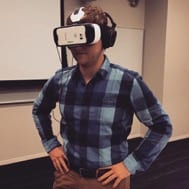 It is virtual reality’s time to shine! While the concept of VR has been around for years, it’s now the “next big thing” in the media and marketing world. Even with industry insiders screaming “FINALLY,” it’s no secret that VR has become a fast-growing space, especially as cameras have improved and viewership numbers increasing every single day.
It is virtual reality’s time to shine! While the concept of VR has been around for years, it’s now the “next big thing” in the media and marketing world. Even with industry insiders screaming “FINALLY,” it’s no secret that VR has become a fast-growing space, especially as cameras have improved and viewership numbers increasing every single day.
I recently had the pleasure of joining Ketchum colleagues Lori Beecher and Bob Peterson, part of the team heading up our VR offering, at an event at 599W showcasing the future of screens. The main focus was on VR and how it’s finally hit the mainstream.
As VR begins to take center-stage for consumers, here are some of the most talked about trends from the event:
1. The Rise of Live Streaming
Between Periscope and Facebook Live launching in the past year, live streaming is now at the forefront for ways that consumers interact with content. While these two live streaming platforms do not support live 360 viewing yet, YouTube has since become the first major player to support live 360 video. The problem, though, is that YouTube lacks the integrated social component. Start-ups like Svrround – who were featured at this event – are trying to change that. They are working on making live 360 video not just easier to stream, but more social in order to create that direct real-time connection between the streamer and the viewer.
Facebook, which supports 360 videos and photos (just not live 360 videos), are probably feeling the pressure more than ever before as major sports and entertainment brands have been inking game-changing, ground-breaking deals in recent months to produce live HD content for VR.
Just like how Snapchat filters and Pokémon Go took off extremely fast, the most-talked about prediction from the event was that live 360 video will be the next “tipping point.” It is important to note, however, that 360 video is not “VR.” Perfecting and mainstreaming live 360 video (with or without a headset) will create a stable stepping stone for live VR content to get off the ground for consumers. It will only be a matter of days before people will demand sitting courtside next to Drake at a Raptors game, Anna Wintour at a New York Fashion Week show, or Jennifer Lawrence at The Oscars.
2. Improvement of Content & Brand Integration Opportunities
The thing that makes VR so unique is how it puts the viewer right in the middle of a fully immersive and engaging experience. It gives them a realistic sense of actually being in the space where everything is happening. This now changes the way that viewers perceive and process visuals – which also means that it should change the way storytellers map-out and create content for VR audiences.
Just a few days ago, the Emmy-nominated series Mr. Robot did just that – they changed the way they created and told their own story. Keeping in tune with the mysterious and transitory theme of the show, fans around the world got to view an exclusive VR experience offered only once through the growing app called Within (formerly Vrse). Viewers got to feel like they were right next to Elliot (played by the brilliant Rami Malek) on one of his adventures during this monumental moment for modern television.
Just as Netflix transformed the way we all consume television through binge-watching, VR is on-track to have a similar impact on the way we engage with, and participate in, all forms of storytelling. We’re no longer passively watching a story, but rather find ourselves right in the middle of it. This provides immense opportunities for creative and innovative branding partnerships in television and film, and especially owned content that brands create for their consumers. The opportunities are endless.
 3. AR in VR
3. AR in VR
In the past year, augmented reality (AR) has “blown up” partly thanks to millennials who want to look like cute puppies. While this may sound like a wasteful use of technological innovation on its surface, it has essentially become the biggest game-changer in the way we are blurring our virtual and real worlds. All of us millennials have done it – and we (secretly or not-so-secretly) love it and continue to send endless ridiculous snaps to our friends.
While VR is already becoming interactive in nature, integrating similar cool AR features will introduce an entirely original element where the consumer can actually engage in real-time and influence the content in ways that aren’t being done right now. Perfecting this will provide a more powerful and engaging experience that could launch the next wave of platforms and technologies. Giving consumers the power to control and interact with the world they are digitally immersed in is how VR will become successful – and better. Simply creating a 360 video and having consumers watch it with a headset will not be what gets the consumer coming back for more. From a marketer’s perspective, integrating interactive AR components into VR content could also provide a whole new standard for tracking behavioral engagement. Is it too much to ask that I watch the next Superbowl in VR and put those same dog ears on the halftime performers’ faces?
VR may seem like the future, but we’re living it right now. It’s exciting, it’s here, and brands need to embrace this new “reality.” (click to tweet)


